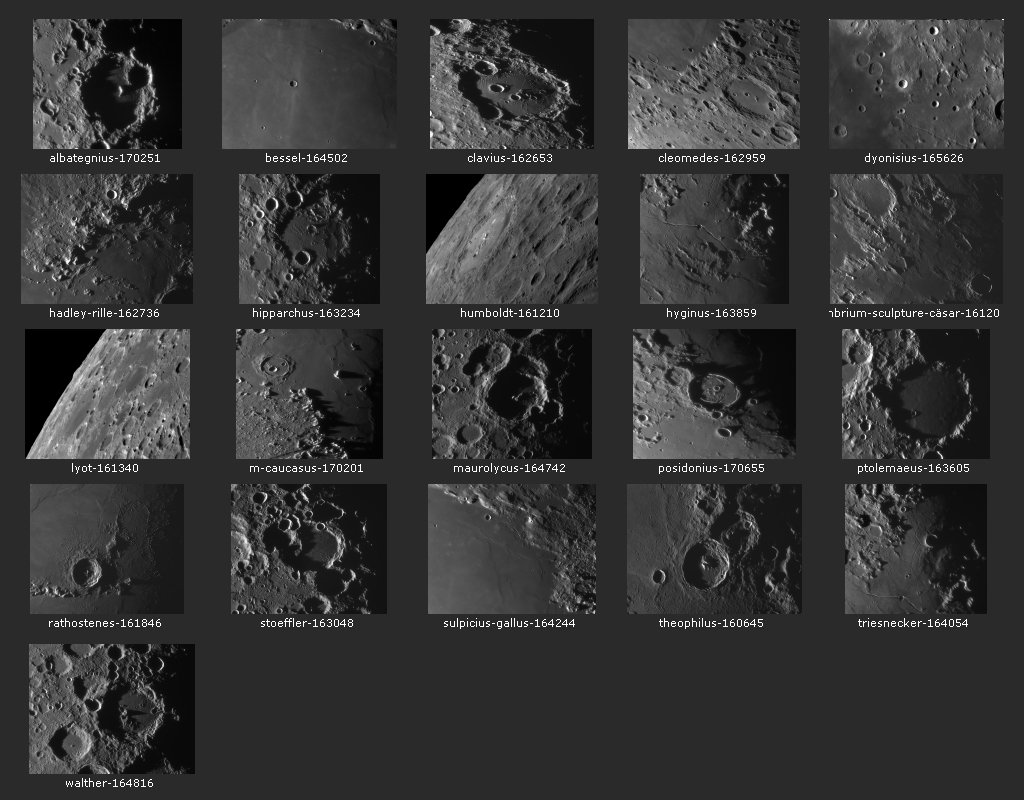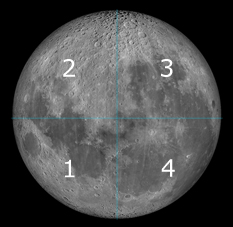| Formation |
Image
description
|
| Albategnius |
The
eastern crater wall of the almost 140 km large crater Albategnius casts
spectacular shadows on the crater floor. To the east (left) lies the strangely
shaped Ritchey crater, which is certainly the result of a multiple
impact. |
| Bessel |
The
picture shows the 17 km large crater Bessel in the Mare Serenitatis over which
a bright strip of ejecta material lies vertically in the picture, which cannot
be assigned to any impact. At the bottom right of the picture is the 3 km Linne
crater, which has played a role in historical moon observations in the question
"are there fast changes on the lunar surface". He was seen by different
observers, by others again not or in other forms. |
| Clavius |
The
photo shows the 225 km large Clavius crater at sunrise. Three mountain peaks
cast long shadows on the crater floor. |
| Cleomedes |
The
picture shows the northern crater wall of Mare Crisium and further north the
130 km large crater Cleomdes. On the crater floor lies the Rimae Cleomedes
groove system, which is extremely difficult to observe due to the perspective
distortion. Along the main groove lie some of the so-called Dark Halo Craters
(DHC), which are surrounded by pyroclastic ash deposits. |
| Dyonisius |
The
picture shows the 18 km large crater Dyonisius in the middle of the picture,
which is surrounded by a ray system alternately by bright and dark material. It
is the only crater on the nearsside of the moon that has such a ray system. To
the east are the Sabine and Ritter craters. To the north the scene shows the
eastern end of Rima Ariadaeus and further north the two shield volcanoes
Aridaeus 1 (smaller) and Julius Caesar 1 (circle marking). |
| Rima Hadley |
The
picture shows an overview of the landing site of Apollo 15 at the Hadley rill,
an old lava canal. The Apennine peaks cast black shadows on the lava surface of
Palus Putredinus. |
| Hipparchus |
The
photo shows the nearly 150 km large heavily eroded crater Hipparchus. The
southeastern crater wall a mountain top in the middle of the crater cast
shadows at sunrise. The large crater that interrupts the northern crater wall
is Horrocks. |
| Humboldt |
The
200 km large Humboldt crater, photographed under optimal libration conditions.
The three large fresh lava flows and the complex groove system are clearly
visible in the image. The image shows - labeled with 1 - one of the rare
concentric double craters on the nearside of the moon. An incredible
view. |
| Rima Hyginus |
Rima
Hyginus, an old delivery channel of lava flow at sunrise. To the north the
pyroclastic ash area Mare Vaporum and to the south (top of the picture) the
northern foothills of the Rimae Triesnecker. |
| Imbrium Sculpture |
The
picture shows the region around the craters Julius Caesar, Boscovich and
Manilius. The radial structures below almost under 45 degrees in the image are
formations that can be traced back to the impact that Mare Imbrium created.
According to the American geologist Gilbert, these formations have been named
"Imbrium Sculpture" since 1893. |
| Lyot |
The
picture shows the 140 km large crater Lyot in the Mare Australe under optimal
libration conditions. |
| Montes Caucasus |
The
scene shows - north of the crater Cassini - the mountain range of the Montes
Caucasus. The high mountain peaks and the Mons Piton cast spectacularly long
shadows on the relatively smooth lava surface of the Mare Crisium. |
| Maurolycus |
The
picture shows the 115 km large crater Maurolycus. A large part of the crater
floor is still in the shadow, the highest parts of the central mountain range
are already shining in the sunlight. |
| Posidonius |
The
almost 100 km large crater Posidonius at sunrise. With this illumination you
can clearly see the different structure of the crater bottom, smooth in the
southwest and otherwise mountainous and rough. The crater walls of Posidonius
and south of Chacornac and Le Monnier cast shadows on the lava surface of Mare
Serenitatis. |
| Ptolemaeus |
The
image shows the 150 km large crater Ptolemy at sunrise. The many small craters
on the ground are not yet visible with this illumination but numerous
depressions in the crater floor become visible. A part of the eastern crater
wall casts a shadow up to the 8 km large crater Ammonius. Directly at the
northeastern crater wall of Ptolemy there is a small, nameless crater chain. At
the top of the picture the peak of the central mountain of Alphonsus is already
in sunlight. |
| Erathostenes |
The
ghost crater Stadius west of Erathostenes and the secondary crater of
Copernicus Impact at sunrise. |
| Stöffler |
The
picture shows the two craters Stöffler and Faraday, whose impact destroyed
the eastern crater wall of Stöffler. The western crater wall casts shadows
on Stöffler's ground. |
| Sulpicius Gallus |
The
picture shows the southwestern part of the Mare Serenitatis. In the smooth lava
surface lies the structure Vallis Krishna (circle marking), a valley-like
structure just 3km long. South of it lies the Pyroclastic Sulpicius Gallus, a
region characterized by pyroclastic volcanism, with its pronounced groove
system. Top left in the picture structures of the "Imbrium Sculpture" are
shown. |
| Theophilus + Catharina |
The
photo shows the craters Mädler, Theophilus and Catharina at sunrise.
Beaumont L is a so-called Dark Halo crater, its diameter is just 4 kilometers.
West of Theophilus the 4 km high mountain Mons Penck casts its
shadow. |
| Rimae Triesnecker |
The
picture shows the 27 km large Triesnecker crater with its pronounced groove
system at sunrise. To the north is the 10 km volcanic Caldera Hyginus. While
the Rima Hyginus is a former lava flow channel, the Rimae Triesnecker are
tectonic fault zones. |
| Walther |
The
scene shows the three craters Nonius (70 km), Aliacensis (80 km) and the 140 km
large crater Walther with its central mountain, which casts a spectacular
shadow on the crater floor. |










